|
|
|
Sort Order |
|
|
|
Items / Page
|
|
|
|
|
|
|
| Srl | Item |
| 1 |
ID:
131794


|
|
|
|
|
| Publication |
2014.
|
| Summary/Abstract |
Between 1952 and 2012, there were a total of 88 successful military coups in Africa. Of those, 63 occurred prior to 1990, and 10 cases since the adoption, by the defunct Organization of African Unity (OAU), of the Lomé Declaration in July 2000, banning military coups and adopting sanctions against regimes born out of this. The article shows that the African Union (AU) has followed in the footsteps of the OAU in this regard. Assisted by some African regional organisations and international partners, the combined effect of this policy of the AU - assisted by other factors - has been a significant reduction in the occurrence of this phenomenon. While not constituting a funeral arrangement for military coups in the immediate future, these developments - if they were to continue - may indeed make this eventuality achievable in the long run. But the article also reveals some challenges the AU is facing in ensuring this.
|
|
|
|
|
|
|
|
|
|
|
|
|
|
|
|
| 2 |
ID:
089394


|
|
|
|
|
| Publication |
2009.
|
| Summary/Abstract |
This article, focusing on the "revive the northeast" programme, examines four questions: why was the northeast region selected as yet another macro-site for Beijing-endorsed scheme of regional development; how does it differ from the "develop the west" scheme; what does the "revive the northeast" scheme entail in concrete policy terms; and how can we assess the impact of this scheme on the region's economic development? While it offers a relatively positive assessment of the programme's impact in facilitating a faster growth during 2004-06, future challenges are also noted for a sustainable development of the northeast region as a whole.
|
|
|
|
|
|
|
|
|
|
|
|
|
|
|
|
| 3 |
ID:
089422


|
|
|
|
|
| Publication |
2009.
|
| Summary/Abstract |
This article, focusing on the "revive the northeast" programme, examines four questions: why was the northeast region selected as yet another macro-site for Beijing-endorsed scheme of regional development; how does it differ from the "develop the west" scheme; what does the "revive the northeast" scheme entail in concrete policy terms; and how can we assess the impact of this scheme on the region's economic development? While it offers a relatively positive assessment of the programme's impact in facilitating a faster growth during 2004-06, future challenges are also noted for a sustainable development of the northeast region as a whole.
|
|
|
|
|
|
|
|
|
|
|
|
|
|
|
|
| 4 |
ID:
043282
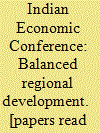

|
|
|
|
|
| Publication |
Bombay, Popular Prakashan, 1969.
|
| Description |
xi,123p.
|
|
|
|
|
|
|
|
|
|
|
|
Copies: C:1/I:0,R:0,Q:0
Circulation
| Accession# | Call# | Current Location | Status | Policy | Location |
| 006233 | 338.9080/IND 006233 | Main | On Shelf | General | |
|
|
|
|
| 5 |
ID:
124314


|
|
|
|
|
| Publication |
2013.
|
| Summary/Abstract |
THE ISSUE OF REGIONAL DEVELOPMENT IS HIGH ON THE POLICY agenda in Central and Eastern Europe (CEE). Indeed, for a variety of reasons, these countries are currently seen as some of the most interesting 'laboratories' for regional development in the European Union (EU) and beyond. First, from a situation in the early and mid-1990s where ?nances for regional development in these countries were very limited, there are now signi?cant levels of funding available. These ?nances ?ow predominantly from the structural funds available under EU cohesion policy, of which CEE member states are the biggest bene?ciaries in the EU. As the contribution by Ferry and McMaster notes, this brings with it opportunities to expand the scope and impact of regional development interventions. However, it also puts pressure on regional policy systems in these countries to develop structures and processes to absorb the funds, to ensure that they contribute to strategic economic growth, and to maintain a clear vision for domestic regional development.
|
|
|
|
|
|
|
|
|
|
|
|
|
|
|
|
| 6 |
ID:
076448
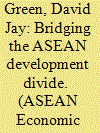

|
|
|
| 7 |
ID:
131835
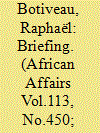

|
|
|
|
|
| Publication |
2014.
|
| Summary/Abstract |
MORE THAN A YEAR AFTER the South African police killed 34 strikers in Marikana, labour unrest continues across the country's mining sector. Industrial actions have targeted platinum giants like Amplats, the world's largest producer, where an 11-day strike over planned retrenchments has just ended and another is looming amid fresh wage talks. Rivalry between the National Union of Mineworkers (NUM) - aligned with the African National Congress (ANC) - and the more recent and militant Association of Mineworkers and Construction Union (AMCU) has also plagued the industry. On 17 October, an NUM branch chairperson at Lonmin - the third largest platinum producer in the world - was shot dead. Another Lonmin NUM shaft steward died in a similar situation on 3 November. A few months ago a former NUM leader who had become the AMCU regional representative in Rustenburg was ambushed - one of several from both sides assassinated since the Marikana massacre. In other words, the 'Framework Agreement for a Sustainable Mining Industry', promoted by South African Deputy President Kgalema Motlanthe and signed by parties to the industry on 3 July 2013, has so far failed to restore peace to the mining sector in Africa's largest economy.
|
|
|
|
|
|
|
|
|
|
|
|
|
|
|
|
| 8 |
ID:
082478


|
|
|
|
|
| Publication |
2008.
|
| Summary/Abstract |
This article analyses the development of relations between indigenous communities, oil companies and the state in Russia's Nenets Autonomous Okrug (NAO). Using first hand information from anthropological fieldwork and one co-author's own involvement in regional politics, we analyse efforts to establish stakeholder dialogue. We show that 'collective agency' is crucial to prepare the ground for trustful relations, whereas high personnel turnover within interest groups jeopardises initially promising initiatives. Lessons from this experience have relevance for similar analyses throughout Russia in those cases where consistent federal and regional legislation is not likely to be in place in the near future
|
|
|
|
|
|
|
|
|
|
|
|
|
|
|
|
| 9 |
ID:
169144
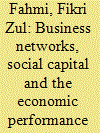

|
|
|
|
|
| Summary/Abstract |
This study examines the ways in which networking characteristics and practices influence the economic performance of creative and cultural industries. The notion of social capital is used to conceptualise the complex nature of networks, including both professional and social relationships that occur on multiple levels. This qualitative study is set in the context of Indonesia, in which two cases are examined: creative apparel entrepreneurs in Bandung and batik producers in Surakarta. The results show that regional environments provide opportunities for creative industries to find specialist suppliers, to gather market information and, importantly, to find and cross‐fertilise new ideas. Although regions provide these opportunities, the firms’ internal social capital is crucial in being able to internalise and transform the knowledge from the environment into innovative values embodied in their products.
|
|
|
|
|
|
|
|
|
|
|
|
|
|
|
|
| 10 |
ID:
180478
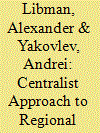

|
|
|
|
|
| Summary/Abstract |
Since 2012, with a view to strengthen the development of strategically important regions, Russia has established several federal agencies responsible for these territories. The essay investigates one of these agencies: the Ministry for the Development of the Far East (Ministerstvo Rossiiskoi Federatsii po razvitiyu Dal’nego Vostoka). We identify two main trade-offs associated with the governance approach used in Russia—between federal power and local knowledge, and between bureaucratic expertise and novel ideas—and examine how the ministry has dealt with these trade-offs and their consequences for the ministry’s performance.
|
|
|
|
|
|
|
|
|
|
|
|
|
|
|
|
| 11 |
ID:
077967
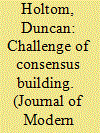

|
|
|
|
|
| Publication |
2007.
|
| Summary/Abstract |
As evidence of the failure of policy-based aid mounted in the early 1990s, a 'new aid agenda' developed. The agenda emphasised among other things, the importance of dialogue and partnership in order to help build ownership of more complex second-generation reforms. The Poverty Reduction Strategy Paper (PRSP) has developed as the key instrument for implementing this partnership in much of sub-Saharan Africa. However, this is not the only objective of the PRSP. Tanzania, at the forefront of attempts to restructure government-donor relations and one of the first countries to prepare a PRSP, illustrates the tensions created by the PRSP's complex genealogy and how these are being worked out in practice
|
|
|
|
|
|
|
|
|
|
|
|
|
|
|
|
| 12 |
ID:
023472
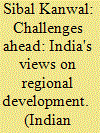

|
|
|
|
|
| Publication |
Oct-Dec 2002.
|
| Description |
21-24
|
|
|
|
|
|
|
|
|
|
|
|
|
|
|
|
| 13 |
ID:
051987


|
|
|
|
|
| Publication |
June 2004.
|
| Summary/Abstract |
One of the predominant issues on the agenda of diplomats and politicians is how to address the consequences of shifts in perception about threats to the environment and the actual short and long-term characteristics and effects of environmental degradation. Another challenge is that such issues as climate change impact on many areas including trade, economic and fiscal policies, employment, transport, agriculture and regional development. Furthermore, decisions taken at a national level cannot be isolated from international concerns, as in the case of the Kyoto Protocol.
This article maps out some of the differences between Australia and the European Union in relation to the role of developing countries in tackling climate change, the use of market mechanisms to tackle environmental problems and the implementation of punitive compliance systems. We explore the challenges facing Australia and the EU in sustainable development, why the EU has a reputation as a leader in this field, how Australia has engaged the challenge and why the similarities in the approach of Australia and the EU are more striking than the differences.
|
|
|
|
|
|
|
|
|
|
|
|
|
|
|
|
| 14 |
ID:
081272
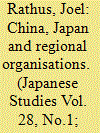

|
|
|
|
|
| Publication |
2008.
|
| Summary/Abstract |
This paper examines the impact of 'the rise of China' on the Asian Development Bank (ADB), and its implications for Japan. Japan has traditionally enjoyed a dominant position in the Bank, as it has enjoyed a dominant position in Asia. However, with the balance of power in the region tipping in China's favour, one might expect that this would be reflected in the ADB as well. This paper argues that despite the worsening Sino-Japanese relationship, the ADB has facilitated the development and maintenance of shared expectations between the two parties over the future direction of development assistance, representing an oasis of liberal institutionalism in a relationship increasingly characterised in realist terms.
|
|
|
|
|
|
|
|
|
|
|
|
|
|
|
|
| 15 |
ID:
111873
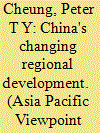

|
|
|
| 16 |
ID:
088470
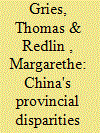

|
|
|
|
|
| Publication |
2009.
|
| Summary/Abstract |
The paper explains the growth-inequality nexus for China's provinces. The theoretical model of provincial development consists of two regions and studies the interactions of a mutually dependent development process. Owing to positive externalities, incoming trade and FDI induce imitation and hence productivity growth. The regional government can influence the economy by changing international transaction costs and providing a public infrastructure. Mobile domestic capital reinforces disparity effects. The implications of the theoretical model are tested. As the central intention of the paper is to explain provincial disparity, we directly relate income disparity (indicated by the contribution to the per capita income Theil index) to the disparity of selected income determining factors (indicated by the contribution to every other Theil index of the determinants). We examine the determinants of inequality for 28 Chinese provinces over the period 1991-2004 and apply a fixed effects panel estimation. The results confirm the theoretical framework and suggest a direct link between the factors that determine regional income and regional disparity. More specifically, it is apparent that disparities in trade, foreign and domestic capital and infrastructure have an impact on the provincial income Theil disparity, whereas provincial disparities in government expenditure and human capital do not seem to drive the income Theil disparity. Therefore, three decades of government reforms led to an extraordinary success of some provinces and increasing inequality. However, government expenditures and public human capital investments seemed to have a stabilizing effect on provincial disparity.
|
|
|
|
|
|
|
|
|
|
|
|
|
|
|
|
| 17 |
ID:
080152
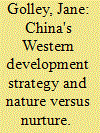

|
|
|
|
|
| Publication |
2007.
|
| Summary/Abstract |
The current trend of rising inequalities in industrial development between East and West China has resulted from a combination of nature and nurture. Given the natural tendency for firms to agglomerate in a developing, market economy, and the numerous geographical and historical factors that have long favoured the Eastern region, it is hardly surprising that this is where Chinese industry has become increasingly agglomerated in recent decades. It is even less surprising in light of deliberate policy choices that compounded, or nurtured, this natural tendency. Left to market forces alone, the agglomeration process should reverse itself (to some extent) in the (very) long-run, as firms relocate to provinces with relatively low costs of production. However, that theoretical long-run is too far away for the Chinese central government, which has introduced a 'Western Development Strategy' to try and speed up economic development in China's poorest region. This paper assesses the likelihood that this Strategy in its current guise will succeed in promoting industrial development in the West.
|
|
|
|
|
|
|
|
|
|
|
|
|
|
|
|
| 18 |
ID:
078030
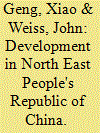

|
|
|
|
|
| Publication |
2007.
|
| Summary/Abstract |
Regional disparities within China are now an important policy question. Recently the three provinces of the north-east region have been identified as priority areas for regional development, along with the Western part of the country. The north-east is the old industrial heartland of the country and its economy is based around heavy industry, mineral extraction and state owned enterprises. This paper uses a unique database on medium and large-scale enterprises to establish how far enterprise performance in the north-east differs from the national average and the reasons for any such differences. It finds that even allowing for industrial structure and ownership, performance in the north-east is significantly below that in the rest of the country. This is attributed to aspects of the investment climate in the region.
|
|
|
|
|
|
|
|
|
|
|
|
|
|
|
|
| 19 |
ID:
186223


|
|
|
|
|
| Summary/Abstract |
Based on a representative survey of new college graduates in China, we present a job location choice model that allows for a self-selection effect in college regions by considering region-dependent heterogeneous preference for job locations and unobservable location features. We also treat endogenous housing costs using the method developed by Berry et al. (1995). Our estimation results show that college education significantly increases graduates' likelihood of working in the city where their college is located. However, a model that does not consider the self-selection effect overestimates this impact. The impact of college location on a graduate's migration decision varies considerably across cities. There is significant heterogeneity between students from universities of different tiers and rural versus urban areas. Meanwhile, the graduates show a marked home preference when choosing their job locations, and they tend to avoid working in cities with high housing costs. These findings shed light on debates on place-based higher education policies and spatial distribution of human capital with a high level of education.
|
|
|
|
|
|
|
|
|
|
|
|
|
|
|
|
| 20 |
ID:
182946
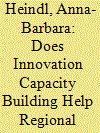

|
|
|
|
|
| Summary/Abstract |
To avoid the middle-income trap, China’s leaders call for innovation to accelerate development in China. However, since it is not clear how innovation and (regional) development reinforce each other, there is no blueprint strategy for successful innovation capacity building throughout China. Due to resource scarcity in its “Western” regions, it is thus far from certain that innovation capacity building will support regional development. Departing from sociology of knowledge, narrations are constitutive of policy practice. This article analyses narrative patterns of policy experts to understand how innovation capacity building and regional development are negotiated in China’s lagging “West.” The comparison of Yunnan and Chongqing cases demonstrates that innovation capacity building is primarily infused with theoretical expectations: resource scarcity does not allow for grounding innovation as a strategy of regional development in the local context. This leads to narrations of “local” alternatives to innovation capacity building in centralist China.
|
|
|
|
|
|
|
|
|
|
|
|
|
|
|
|
|
|
|
|
|